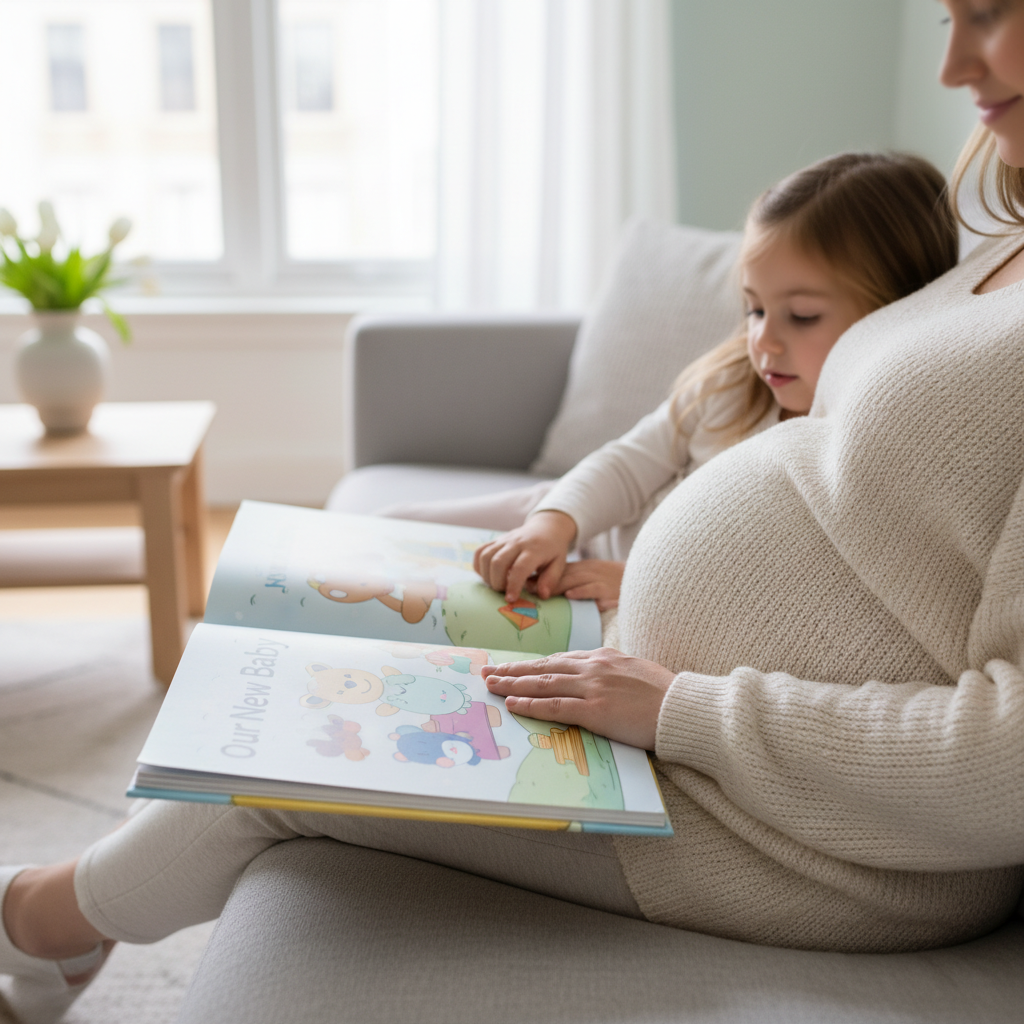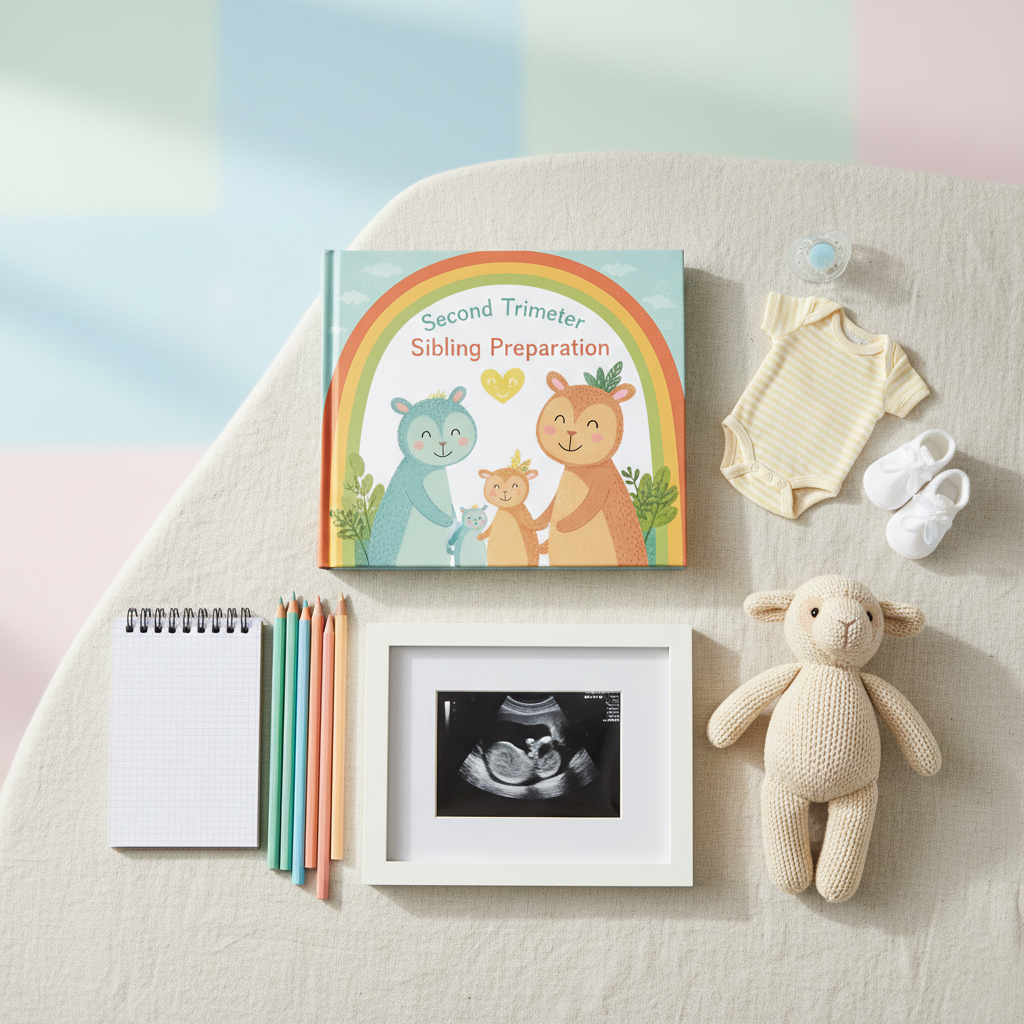
Involving Siblings-to-Be in the Pregnancy Journey
Preparing your child for a new sibling is one of the most important aspects of a growing family’s journey during pregnancy. The way you introduce and involve your existing children in this special time can set the foundation for healthy sibling relationships that last a lifetime.
Key Highlights
Here are the essential strategies for preparing your child for a new sibling:
- Share the news early and in an age-appropriate, special way that makes your child feel included
- Involve siblings in tangible experiences like hearing the baby’s heartbeat or attending ultrasound appointments
- Use books, stories, and visual aids to help children understand what’s happening
- Give children meaningful roles in preparing for baby’s arrival
- Maintain routines and one-on-one time to reassure your firstborn of your continued love
Understanding Changes: Breaking the Big News

When you reach the second trimester, it’s often the ideal time to share your pregnancy news with your older child. This timing works well because the risk of pregnancy loss decreases significantly, and you might be starting to show physical changes that will prompt questions. Children benefit from early inclusion in the family’s journey, as it gives them time to process the big change ahead and feel like valued participants rather than afterthoughts.
The way you break the news matters significantly. Consider creating a special moment—perhaps with a “big brother” or “big sister” gift, a picture book about new siblings, or a simple conversation during a cherished routine like bedtime stories. According to child development experts at the American Academy of Pediatrics, using concrete language like “There’s a baby growing in Mommy’s tummy” is more helpful than abstract explanations. Remember to emphasize how special their role as an older sibling will be, while also acknowledging that they might have mixed feelings about sharing your attention.
Understanding Changes: Making the Pregnancy Real
During the middle months of pregnancy, find opportunities to make the baby’s existence tangible for your child. Bringing your child to an ultrasound appointment where they can see the baby moving on screen can transform an abstract concept into something real and exciting. Many children find hearing the baby’s heartbeat through a doppler during a doctor’s visit to be a magical experience that creates a first connection.
As your pregnancy progresses, encourage your child to feel the baby’s movements and kicks. You might say, “The baby is kicking! Would you like to feel it?” This physical connection helps siblings begin bonding before birth. Some families create rituals like having the sibling talk or sing to the baby each night, which pediatric psychologists note can foster early attachment. These shared experiences are especially meaningful as you navigate through changing relationships during the second trimester.
Your Body & Baby: Learning Through Stories

Books about welcoming a new sibling are powerful tools for helping children understand and prepare for this life change. Age-appropriate stories can address common concerns, normalize feelings of jealousy or worry, and paint positive pictures of sibling relationships. Libraries and bookstores offer dedicated sections with titles like “The New Baby,” “I’m a Big Sister/Brother Now,” or “There’s a House Inside My Mommy” that use gentle language and illustrations to explain concepts like pregnancy and birth.
For toddlers and preschoolers, picture books with simple storylines work best, while older children might benefit from books that provide more biological details about how babies develop. Some parents create customized photo books that tell the story of when the older child was born, reinforcing how excited everyone was about their arrival and drawing parallels to the coming baby. Child psychologists at the Child Mind Institute recommend reading these books repeatedly throughout pregnancy, as repetition helps children process information and provides opportunities for them to ask different questions as their understanding evolves.
Your Body & Baby: Creating Ownership Through Involvement
Children who feel actively involved in preparing for a new baby are more likely to develop positive feelings about their sibling’s arrival. Invite your child to help decorate the nursery by choosing colors, helping paint, or creating artwork for the walls. This involvement gives them a sense of pride and connection to the baby’s space. Many families experiencing pregnancy headaches second trimester find that involving siblings in small, manageable projects provides a welcome distraction and positive focus.
Consider taking your child shopping to select a special toy or blanket they can give to the baby as a “welcome gift.” Some parents also involve children in selecting potential names, listening seriously to their suggestions even if they don’t ultimately choose “Elsa” or “Spider-Man.” According to family therapists, these collaborative activities help children feel like valued contributors to the family transition rather than passive bystanders. For creative ways to involve siblings, many families incorporate them into gender reveal celebrations which can be particularly memorable.
Healthy Living Tips: Building the Helper Mindset

Cultivating a “helper” identity in your child creates excitement about their new role and builds confidence in their abilities. Start by teaching age-appropriate skills they’ll use when the baby arrives. Toddlers can practice gentle touches on a doll, preschoolers can learn how to fetch diapers or sing soothing songs, and school-age children might learn to hold a baby safely while sitting. These practical skills give children concrete ways to participate in baby care.
Use positive language that emphasizes their importance: “You’re going to be such a helpful big brother!” or “Babies love looking at their big sisters!” Child psychologists note that this framing helps children view the new baby as someone who admires them rather than competes with them. Some families create a special “helper kit” with items like baby wipes, small books for reading to the baby, and a water bottle for helping during feeding time. This preparation during pregnancy sets the stage for positive involvement after birth and builds anticipation rather than anxiety about the changes ahead.
Healthy Living Tips: Maintaining Your First Child’s World
While preparing for a new baby is exciting, it’s equally important to maintain stability in your older child’s life. Children thrive on routine, so try to keep regular schedules for meals, bedtimes, and activities even as you prepare for the baby. This consistency provides security during a time of change. If your child will need to switch rooms or transition from a crib to a bed, make these changes well before the baby arrives (ideally by the 2nd month of pregnancy) to avoid your child feeling displaced by the newcomer.
Plan regular one-on-one time with your existing child and talk about how you’ll continue special activities after the baby arrives. You might say, “Even when the baby comes, we’ll still have our Saturday morning pancakes together.” Child development experts at Zero to Three recommend creating concrete plans for how other family members can help maintain important routines when you’re busy with the newborn. Consider setting up a special box of new activities that your child can enjoy during feeding times, and talk openly about how babies need lots of care at first, but this won’t change how much you love your firstborn. These reassurances, combined with actions that demonstrate your continued commitment, help children feel secure in their place in the family during this transition.
Embracing This Special Time Together
Preparing a child for a new sibling is about more than just avoiding jealousy—it’s about laying the groundwork for a lifelong relationship. By thoughtfully involving your child throughout the pregnancy, you’re not only easing the transition but also teaching valuable lessons about family, change, and love. The time and attention you invest now will pay dividends in smoother adjustments after birth and potentially stronger sibling bonds for years to come. Remember that each child will respond differently to this transition, and flexibility along with consistent reassurance will help your growing family navigate this beautiful journey together.
